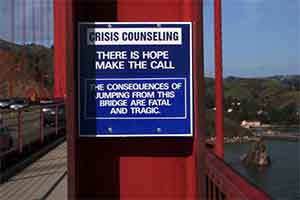Suicide prevention strategies revisited: a 10-year systematic review
 A major international review of suicide prevention has confirmed that some methods do work in reducing suicides, whereas others currently in use still have little proven effectiveness.
A major international review of suicide prevention has confirmed that some methods do work in reducing suicides, whereas others currently in use still have little proven effectiveness.
Worldwide, there are more than 800,000 suicides every year, although for every successful suicide there are around 30 attempts. More people are killed by suicide than by war and homicide put together. In younger people (aged 15-29), suicide is the second-leading cause of death. Information on suicide prevention is urgently needed. Now a major new study from the Expert Platform on Mental Health, Focus on Depression, and the European College of Neuropsychopharmacology (ECNP) has evaluated strategies for suicide prevention. The paper is published in Lancet Psychiatry.
One of the main findings is that restricting easy access to ways of taking your own life is a key element, as is shown by the drop in suicides in countries which decrease the number of pills in packets of analgesics (such as aspirin and paracetamol). Other effective measures include physical barriers being erected at known suicide spots such as high bridges. The report concludes that if an impulsive attempted suicide is deterred, often these measures are enough to save a life.
Some medical treatments have been shown to be effective in certain populations. For example, the drugs lithium and Clozapine have proven benefits in some populations. Drugs for depression have been shown to reduce suicides in the over 75s. In children and adolescents serotonin medications have the potential to increase suicidal thoughts, although there is no evidence that actual suicides increase (the paper notes that untreated depression in children is also a risk, and so drugs for depression may be considered for use, with close monitoring).
Other strategies include Gatekeeper Training, special training of GPs, professionals at schools and the workplace to recognise at-risk behaviour, which was also found to be useful, but only if integrated with other methods of suicide prevention. Follow-up of people who have attempted suicide is strongly recommended.
Professor Joseph Zohar (Tel Aviv), one of the authors of the paper said:
“We reviewed nearly 1800 scientific papers on suicide published between 2005 and 2015. We found that there is no single way of preventing suicide; however implementation of the evidence-supported methods described in this study, including public and physician education and awareness together with appropriate legislation, has the potential to change public health strategies in suicide prevention plans. With these measures, we can significantly reduce the number of deaths due to suicide”.
ECNP President, Professor Guy Goodwin (Oxford) commented:
“The ECNP is proud to have supported this network of colleagues across Europe to conduct this definitive review of what works in suicide prevention. As is still not sufficiently known, suicide is always among the commonest causes of death in young people. Policies to reduce it need to be evidence based and this review highlights where evidence does and does not exist currently”.
Source: European College of Neuropsychopharmacology (ECNP)
Full bibliographic information:
Suicide prevention strategies revisited: 10-year systematic review
Lancet Psychiatry 2016

